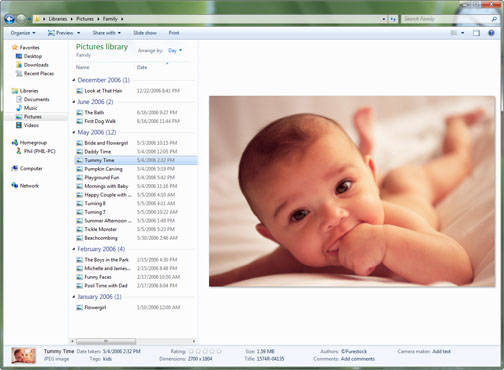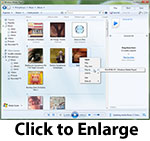Windows 7 goes Release Candidate
11/05/09 10:20 Filed in: Technology
Published in the Business Guardian, May 07, 2009.

The new folder level Preview Pane view in Windows 7. Images courtesy Microsoft.
The Trinidad Guardian was invited exclusively to join a teleconference with Mike Nash, Corporate Vice President of the Windows Marketing Group and a select group of 20 journalists from the Latin American region as the software company announced its plans for the final stages of its testing for the newest version of Windows.
Microsoft is investing a lot of effort in raising the public profile of its newest release of its flagship software, the Windows operating system (OS) after the less than enthusiastic welcome that Windows Vista received in 2007.
The cycle of development for Windows 7 has been accelerated and while the product has been announced for early 2010, the pace of Microsoft's development and the announcement of a first version of a release candidate version this early in 2009, paired with market pressures, suggests that the company is aiming at a late 2009 release date. Microsoft declined to comment on release timelines during the conference call.
There was, however, a lot of discussion about just how great Windows 7 will be, and Microsoft really needs to jump-start that kind of conversation, given how tarnished the reputation of Vista has become since its introduction.
"There's been a lot of learning about how we should build operating system software for our ecosystem partners," said Mike Nash. "Windows 7 is an opportunity to build on the work we've done with Windows Vista. The key here is not to create a lot of churn."
Acknowledging that the first users of Windows Vista "didn't have everything they needed," Nash noted that the company had delivered an API (Application Programming Interface) complete version of Windows 7 to developers and a feature complete version of the operating system to curious users as a public beta in April 2009.
 That public testing continues on May 5 with the release of Windows 7 RC1, a version that's close to the final product and a release that Microsoft is clearly positioning as a valentine for disgruntled Vista users and first adopters keen to enjoy a leaner, faster version of Windows.
That public testing continues on May 5 with the release of Windows 7 RC1, a version that's close to the final product and a release that Microsoft is clearly positioning as a valentine for disgruntled Vista users and first adopters keen to enjoy a leaner, faster version of Windows.
Despite Nash's statement that Microsoft is not planning to create "churn," some turbulence the OS marketplace is exactly what the company needs now.
It's no secret that Microsoft's worst competition in the market for OS upgrades is older versions of Windows. While the company drives most of its new system software sales through manufacturers building new PCs, it also benefits from sales of upgrades from previous versions, particularly in the corporate markets.
Windows Vista was the first Microsoft OS upgrade to meet not just resistance in traditional upgrade markets, it encountered outright defiance, as manufacturers, pressured by their customers, negotiated with the company to extend their "downgrade" licenses for Windows XP for new system buyers who didn't want Vista.
The extended public testing of Windows 7 might be just what Microsoft claims it is, an opportunity to learn from their public and their developer community, but it might also be an extended soft launch of an operating system that the company hopes will do what Vista was supposed to, become the dominant version of Windows in use around the world.
To do that, the OS will have to prove to be more scalable than Vista was and prove itself a viable OS for the exploding market for netbooks, the underpowered and scaled down laptops that have dominated new computer sales over the last six months.
Nash noted that Windows 7 will work on netbooks, though it's unclear yet whether the OS will run on the earliest and leanest netbooks or newer versions, which have faster processors and more disk and memory resources.
At this stage of the product's development, Microsoft is promoting Windows 7 as a compatible OS. Any device that works with Vista will work with Windows 7, and the company will be offering an "XP Mode" for enterprise customers that uses virtualisation technology (based on their product Virtual PC) to create an XP shell for older software. XP mode will require at least 1GB RAM and 16GB of disk space. Windows 7 will also report its version internally as 6.1, as an additional safeguard for software that checks OS versions before running.
The company is creating a web based resource, the Windows Compatibility Centre, which will aggregate information about how third party software works with the new OS and an improved software Upgrade Advisor will offer analysis of compatibility with your existing hardware and software.
"Ninety-four percent of users have all of their devices working on Vista," said Nash, "and software that has low-level hooks into the OS like anti-virus and disk imaging have received special attention by the software development team."
 It isn't all hardware and software in the Windows 7 announcements. Microsoft has allowed itself some room for fun; building in an option for remote media access that allows a user access to movies and music on a media centre enabled PC via the Internet. This is not news that's likely to amuse Slingbox, who have built their business on exactly this feature proposition.
It isn't all hardware and software in the Windows 7 announcements. Microsoft has allowed itself some room for fun; building in an option for remote media access that allows a user access to movies and music on a media centre enabled PC via the Internet. This is not news that's likely to amuse Slingbox, who have built their business on exactly this feature proposition.
Bitlocker to go, an advance on the disk encryption technology introduced with Vista has now been extended to flash drives and other removable read/write devices, protecting data as it moves from computer to computer.
The new OS also supports Microsoft's version of VPN, which will allow users to access computers in corporate locations securely from remote locations. Limited time for questions didn't allow anyone a chance to query whether this new access option will be compatible with traditional VPN technologies.
One journalist did manage to ask Nash about customers who may be delaying purchases while waiting for a final release of Windows 7.
Nash had no ready response for this, but it's a legitimate concern. The extended testing of Windows has whetted the appetite of the bleeding edge of Microsoft's users for an OS that's more compact, and faster than Vista proved to be, but many customers won't mess around with incomplete software, no matter how stable it's touted to be.
Windows 7 will be a paid upgrade from Vista and earlier Windows versions and will be delivered in versions. According to Mike Nash, "each version will build on the features of the one before it."
The company clearly hopes to avoid some of the confusion that the myriad system versions of Vista created and is differentiating most of the versions of the new OS by using different software keys.
If you install a basic version of Windows 7, upgrading to a more advanced version of the software won't require a reinstall and fresh downloads, you should be able to just buy an upgrade software key that will unlock new features in your existing installation.
Microsoft expects that most customers will find Windows 7 Professional to be the sweet spot of the new product line while Windows 7 Home Premium is said to run on a netbook.
Windows 7 Starter edition is targeted at netbooks in emerging markets.
Testers interested in the Windows 7 RC1 testing cycle may be heartened that Microsoft intends to keep the software active until mid-2010, much longer than any previous test version. By comparison, the first Windows 7 public beta only functioned for a few months.
Related:
BitDepth 679
BitDepth 666

The new folder level Preview Pane view in Windows 7. Images courtesy Microsoft.
The Trinidad Guardian was invited exclusively to join a teleconference with Mike Nash, Corporate Vice President of the Windows Marketing Group and a select group of 20 journalists from the Latin American region as the software company announced its plans for the final stages of its testing for the newest version of Windows.
Microsoft is investing a lot of effort in raising the public profile of its newest release of its flagship software, the Windows operating system (OS) after the less than enthusiastic welcome that Windows Vista received in 2007.
The cycle of development for Windows 7 has been accelerated and while the product has been announced for early 2010, the pace of Microsoft's development and the announcement of a first version of a release candidate version this early in 2009, paired with market pressures, suggests that the company is aiming at a late 2009 release date. Microsoft declined to comment on release timelines during the conference call.
There was, however, a lot of discussion about just how great Windows 7 will be, and Microsoft really needs to jump-start that kind of conversation, given how tarnished the reputation of Vista has become since its introduction.
"There's been a lot of learning about how we should build operating system software for our ecosystem partners," said Mike Nash. "Windows 7 is an opportunity to build on the work we've done with Windows Vista. The key here is not to create a lot of churn."
Acknowledging that the first users of Windows Vista "didn't have everything they needed," Nash noted that the company had delivered an API (Application Programming Interface) complete version of Windows 7 to developers and a feature complete version of the operating system to curious users as a public beta in April 2009.

Despite Nash's statement that Microsoft is not planning to create "churn," some turbulence the OS marketplace is exactly what the company needs now.
It's no secret that Microsoft's worst competition in the market for OS upgrades is older versions of Windows. While the company drives most of its new system software sales through manufacturers building new PCs, it also benefits from sales of upgrades from previous versions, particularly in the corporate markets.
Windows Vista was the first Microsoft OS upgrade to meet not just resistance in traditional upgrade markets, it encountered outright defiance, as manufacturers, pressured by their customers, negotiated with the company to extend their "downgrade" licenses for Windows XP for new system buyers who didn't want Vista.
The extended public testing of Windows 7 might be just what Microsoft claims it is, an opportunity to learn from their public and their developer community, but it might also be an extended soft launch of an operating system that the company hopes will do what Vista was supposed to, become the dominant version of Windows in use around the world.
To do that, the OS will have to prove to be more scalable than Vista was and prove itself a viable OS for the exploding market for netbooks, the underpowered and scaled down laptops that have dominated new computer sales over the last six months.
Nash noted that Windows 7 will work on netbooks, though it's unclear yet whether the OS will run on the earliest and leanest netbooks or newer versions, which have faster processors and more disk and memory resources.
At this stage of the product's development, Microsoft is promoting Windows 7 as a compatible OS. Any device that works with Vista will work with Windows 7, and the company will be offering an "XP Mode" for enterprise customers that uses virtualisation technology (based on their product Virtual PC) to create an XP shell for older software. XP mode will require at least 1GB RAM and 16GB of disk space. Windows 7 will also report its version internally as 6.1, as an additional safeguard for software that checks OS versions before running.
The company is creating a web based resource, the Windows Compatibility Centre, which will aggregate information about how third party software works with the new OS and an improved software Upgrade Advisor will offer analysis of compatibility with your existing hardware and software.
"Ninety-four percent of users have all of their devices working on Vista," said Nash, "and software that has low-level hooks into the OS like anti-virus and disk imaging have received special attention by the software development team."
 It isn't all hardware and software in the Windows 7 announcements. Microsoft has allowed itself some room for fun; building in an option for remote media access that allows a user access to movies and music on a media centre enabled PC via the Internet. This is not news that's likely to amuse Slingbox, who have built their business on exactly this feature proposition.
It isn't all hardware and software in the Windows 7 announcements. Microsoft has allowed itself some room for fun; building in an option for remote media access that allows a user access to movies and music on a media centre enabled PC via the Internet. This is not news that's likely to amuse Slingbox, who have built their business on exactly this feature proposition.Bitlocker to go, an advance on the disk encryption technology introduced with Vista has now been extended to flash drives and other removable read/write devices, protecting data as it moves from computer to computer.
The new OS also supports Microsoft's version of VPN, which will allow users to access computers in corporate locations securely from remote locations. Limited time for questions didn't allow anyone a chance to query whether this new access option will be compatible with traditional VPN technologies.
One journalist did manage to ask Nash about customers who may be delaying purchases while waiting for a final release of Windows 7.
Nash had no ready response for this, but it's a legitimate concern. The extended testing of Windows has whetted the appetite of the bleeding edge of Microsoft's users for an OS that's more compact, and faster than Vista proved to be, but many customers won't mess around with incomplete software, no matter how stable it's touted to be.
Windows 7 will be a paid upgrade from Vista and earlier Windows versions and will be delivered in versions. According to Mike Nash, "each version will build on the features of the one before it."
The company clearly hopes to avoid some of the confusion that the myriad system versions of Vista created and is differentiating most of the versions of the new OS by using different software keys.
If you install a basic version of Windows 7, upgrading to a more advanced version of the software won't require a reinstall and fresh downloads, you should be able to just buy an upgrade software key that will unlock new features in your existing installation.
Microsoft expects that most customers will find Windows 7 Professional to be the sweet spot of the new product line while Windows 7 Home Premium is said to run on a netbook.
Windows 7 Starter edition is targeted at netbooks in emerging markets.
Testers interested in the Windows 7 RC1 testing cycle may be heartened that Microsoft intends to keep the software active until mid-2010, much longer than any previous test version. By comparison, the first Windows 7 public beta only functioned for a few months.
Related:
BitDepth 679
BitDepth 666
blog comments powered by Disqus